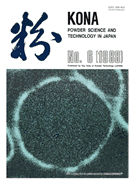Volume 6
Displaying 1-18 of 18 articles from this issue
- |<
- <
- 1
- >
- >|
Front Cover
-
1988 Volume 6 Pages Cover6_1
Published: 1988
Released on J-STAGE: June 30, 2014
Download PDF (329K) -
1988 Volume 6 Pages EdBrd6_1
Published: 1988
Released on J-STAGE: June 30, 2014
Download PDF (608K)
Comment of the Cover Photograph
-
1988 Volume 6 Pages a-b
Published: 1988
Released on J-STAGE: June 30, 2014
Download PDF (304K)
Original Report
-
1988 Volume 6 Pages 2-14
Published: 1988
Released on J-STAGE: June 30, 2014
Download PDF (818K) -
1988 Volume 6 Pages 15-22
Published: 1988
Released on J-STAGE: June 30, 2014
Download PDF (507K) -
1988 Volume 6 Pages 23-29
Published: 1988
Released on J-STAGE: June 30, 2014
Download PDF (439K) -
1988 Volume 6 Pages 30-38
Published: 1988
Released on J-STAGE: June 30, 2014
Download PDF (575K) -
1988 Volume 6 Pages 39-46
Published: 1988
Released on J-STAGE: June 30, 2014
Download PDF (505K) -
1988 Volume 6 Pages 47-56
Published: 1988
Released on J-STAGE: June 30, 2014
Download PDF (664K) -
1988 Volume 6 Pages 57-64
Published: 1988
Released on J-STAGE: June 30, 2014
Download PDF (418K) -
1988 Volume 6 Pages 65-71
Published: 1988
Released on J-STAGE: June 30, 2014
Download PDF (457K) -
1988 Volume 6 Pages 72-85
Published: 1988
Released on J-STAGE: June 30, 2014
Download PDF (885K)
Review
-
1988 Volume 6 Pages 86-97
Published: 1988
Released on J-STAGE: June 30, 2014
Download PDF (760K) -
1988 Volume 6 Pages 98-110
Published: 1988
Released on J-STAGE: June 30, 2014
Download PDF (979K)
Information Articles
-
1988 Volume 6 Pages 111
Published: 1988
Released on J-STAGE: June 30, 2014
Download PDF (108K) -
1988 Volume 6 Pages 112
Published: 1988
Released on J-STAGE: June 30, 2014
Download PDF (90K)
Academic publication concerning powder technology in Japan
-
1988 Volume 6 Pages 113-116
Published: 1988
Released on J-STAGE: June 30, 2014
Download PDF (228K)
New Product News
-
1988 Volume 6 Pages 117
Published: 1988
Released on J-STAGE: June 30, 2014
Download PDF (596K)
- |<
- <
- 1
- >
- >|
